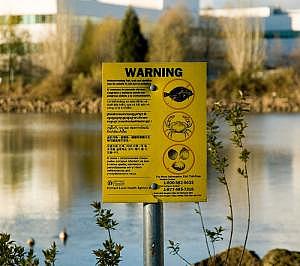Unsafe to consume
Contaminated waters mean exposure to 42 chemicals for people who consume fish from the Duwamish River, despite posted warnings. For those who depend on the river as a primary food source, this frightening possibility is not enough of a deterrent.

Some anglers who ignore posted warnings are under the impression that cooking the fish found in contaminated water removes any danger.
People aren’t supposed to eat the fish they catch in the Duwamish. But here’s the dirty river’s dirty secret: They do.
“People fish on the river,” said B.J. Cummings of the Duwamish River Cleanup Coalition, a nonprofit coalition of environmentalists, neighborhood groups, local businesses and Duwamish tribes. “These are people with little or no income and people for whom fishing is a really important cultural practice.”
The river is a source of food for tribal, immigrant and low-income anglers, despite post warnings telling them not to eat the fish.
A recent survey conducted by Public Health -- Seattle & King County confirmed that anglers are eating what they catch. Some because they don’t understand the warnings, or falsely believe that cooking will remove contamination.
Others because they said they don’t believe the warnings, or don’t care.
Morgan Barry, an outreach educator for Public Health – Seattle & King County, who helped organize the survey, recalls an encounter with an older man who was fishing the river. He told her he used to live downwind of the Hanford Nuclear Reservation, she recalled, and that he used to work with asbestos in the shipyards.
“He told me, ‘Everybody gets cancer,’ ” she said. In his world, that was just the way it was.
There are some 42 chemicals above federal standards in the river bed, including PCBs, dioxins, carcinogenic hydrocarbons, and arsenic. They are all chemicals known to cause cancer or other health effects, including reproductive harm, and immune system or neurological disorders.
The chemicals concentrate in the flesh of fish that spend their lives in the river, especially the bottom fish that feed off bugs and other nutrients in the river’s bottom. The various cleanup options won’t completely remove the need for fish advisories, Cummings said.
That’s a no-win situation, said Cummings. If the advisories work and people obey them, they take away a food source from people who need it. If they don’t work and people eat the fish anyway, they can get sick.
Lack of access to healthy food and good nutrition are significant issues for the neighborhoods along the river, yet none of the proposed cleanup options, which range in cost from $230 million to $1.3 billion, will get the river clean enough for people to safely consume as much resident fish and shellfish as they want.
That has already created tension between community activist groups, who want the river clean enough to fish for food, and the EPA, which says it may be impossible to clean it up to the point where no “fish advisories” limiting consumption will be needed.
That’s because no matter how much “historical pollution” is removed from the immediate five-mile stretch of river, new contamination leaks in from upstream all the time – pollution for which the EPA says it is not responsible.
“We don’t know if it’s possible to get to zero (levels of contamination) in the Duwamish,” said Wenona Wilson, head of the Environmental Justice group for Region 10. “Our job is to reduce the risk as much as possible in the most effective way.”
The coalition has been pushing the EPA to consider cleaning up the upriver sources of contamination so that people could eat more of the fish.
From an environmental justice perspective, having permanent fishing advisories but not upriver source control is not acceptable, she said. “They’re asking people to change really important cultural practices.”

